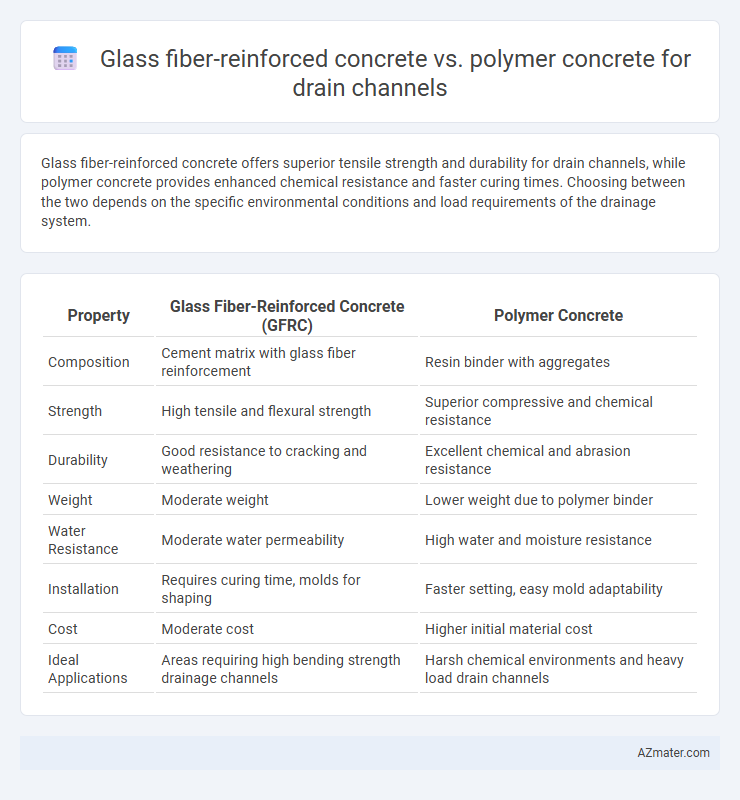Glass fiber-reinforced concrete offers superior tensile strength and durability for drain channels, while polymer concrete provides enhanced chemical resistance and faster curing times. Choosing between the two depends on the specific environmental conditions and load requirements of the drainage system.
Table of Comparison
| Property | Glass Fiber-Reinforced Concrete (GFRC) | Polymer Concrete |
|---|---|---|
| Composition | Cement matrix with glass fiber reinforcement | Resin binder with aggregates |
| Strength | High tensile and flexural strength | Superior compressive and chemical resistance |
| Durability | Good resistance to cracking and weathering | Excellent chemical and abrasion resistance |
| Weight | Moderate weight | Lower weight due to polymer binder |
| Water Resistance | Moderate water permeability | High water and moisture resistance |
| Installation | Requires curing time, molds for shaping | Faster setting, easy mold adaptability |
| Cost | Moderate cost | Higher initial material cost |
| Ideal Applications | Areas requiring high bending strength drainage channels | Harsh chemical environments and heavy load drain channels |
Introduction to Drain Channel Materials
Glass fiber-reinforced concrete (GFRC) offers enhanced tensile strength and durability for drain channels, improving resistance to cracking and environmental stress. Polymer concrete combines polymers with aggregates, delivering superior chemical resistance and rapid curing, ideal for harsh or corrosive drainage environments. Both materials surpass traditional concrete in longevity and performance, demanding careful selection based on site-specific conditions and load requirements.
Overview of Glass Fiber-Reinforced Concrete (GFRC)
Glass Fiber-Reinforced Concrete (GFRC) consists of Portland cement, fine aggregates, water, and alkali-resistant glass fibers, forming a composite material with high tensile strength and durability. GFRC exhibits excellent resistance to cracking, weathering, and chemical exposure, making it an ideal choice for drain channel applications requiring long service life and structural integrity. Its lightweight nature and enhanced flexural strength provide superior load-bearing capacity compared to traditional concrete and polymer concrete alternatives.
Overview of Polymer Concrete
Polymer concrete is a composite material consisting of resin binders and aggregates, offering superior chemical resistance and high compressive strength ideal for drain channel applications. It demonstrates excellent durability against corrosive environments, making it preferable over glass fiber-reinforced concrete in areas exposed to aggressive chemicals or wastewater. The fast curing time and reduced permeability of polymer concrete enhance its performance and longevity in drainage infrastructure.
Composition and Material Properties Comparison
Glass fiber-reinforced concrete (GFRC) consists of a cementitious matrix combined with alkali-resistant glass fibers, providing high tensile strength and enhanced durability against cracking and abrasion. Polymer concrete, composed of aggregates bonded with synthetic resins such as epoxy or polyester, offers superior chemical resistance, reduced permeability, and faster curing times compared to traditional cement-based composites. GFRC excels in structural flexibility and impact resistance, whereas polymer concrete delivers better performance in aggressive chemical environments and has higher compressive strength, making the choice dependent on specific operational requirements for drain channels.
Mechanical Strength and Durability Analysis
Glass fiber-reinforced concrete (GFRC) demonstrates superior tensile strength and impact resistance compared to polymer concrete, making it highly effective for load-bearing drain channels. GFRC's enhanced durability stems from its ability to resist cracking and weathering under cyclic thermal and moisture exposure, ensuring long service life in harsh environmental conditions. In contrast, polymer concrete offers excellent chemical resistance and rapid curing but generally exhibits lower mechanical strength and reduced abrasion resistance, limiting its application where heavy structural loads are prevalent.
Chemical Resistance and Environmental Performance
Glass fiber-reinforced concrete (GFRC) exhibits superior chemical resistance against acids, alkalis, and sulfates commonly found in drain channel environments, reducing degradation and extending service life. Polymer concrete offers enhanced impermeability and resistance to aggressive chemicals, providing excellent environmental performance by preventing pollutant infiltration and reducing maintenance frequency. Both materials contribute to sustainable infrastructure, with GFRC facilitating high durability and polymer concrete supporting eco-friendly drainage systems through reduced chemical leaching.
Installation and Handling Considerations
Glass fiber-reinforced concrete (GFRC) offers lightweight properties and high tensile strength, facilitating easier handling and faster installation of drain channels with reduced labor costs and minimal formwork requirements. Polymer concrete provides excellent chemical resistance and durability but can be heavier and more rigid, demanding specialized equipment and careful handling during placement to avoid cracking. Both materials require attention to curing times; GFRC typically cures faster, allowing quicker installation cycles compared to the generally longer curing process of polymer concrete.
Cost Efficiency and Lifecycle Analysis
Glass fiber-reinforced concrete (GFRC) offers superior durability and lower maintenance costs compared to polymer concrete, making it more cost-efficient over long-term use in drain channels. Although polymer concrete provides excellent chemical resistance and faster installation, its higher initial cost and shorter lifespan often increase overall expenses in lifecycle analysis. GFRC's enhanced structural integrity and weather resistance contribute to reduced repair frequency, optimizing total cost of ownership.
Application Suitability in Drain Channel Systems
Glass fiber-reinforced concrete (GFRC) offers superior tensile strength and crack resistance, making it ideal for drain channels exposed to dynamic loads and thermal expansion. Polymer concrete provides excellent chemical resistance and low permeability, suitable for drain channels in aggressive environments or those subjected to corrosive wastewater. Choosing between GFRC and polymer concrete depends on specific application requirements such as load-bearing capacity, environmental exposure, and maintenance needs.
Conclusion: Choosing the Right Material for Drain Channels
Glass fiber-reinforced concrete (GFRC) offers superior tensile strength and durability, making it ideal for high-load and impact-resistant drain channels. Polymer concrete provides excellent chemical resistance and rapid curing times, suited for aggressive environments with frequent exposure to chemicals or corrosive agents. Selecting the right material depends on specific project requirements, balancing load-bearing capacity and environmental durability for optimal drain channel performance.

Infographic: Glass fiber-reinforced concrete vs Polymer concrete for Drain channel
 azmater.com
azmater.com